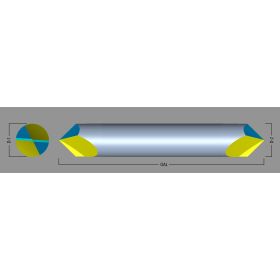Choosing The Best Chamfer Cutter Tip Geometry
A chamfer cutter, or a chamfer mill, is available at any machine shop, assembly floor, or hobbyist’s garage. These cutters are pretty straight forward tools which might be useful for chamfering or beveling any area in a wide range of materials. A lot of to chamfer an important part, which range from fluid flow and safety, to part aesthetics.

Due to the diversity of needs, tooling manufacturers offer many different angles and sizes of chamfer cutters, and also different types of chamfer cutter tip geometries. Harvey Tool, as an example, offers 21 different angles per side, ranging from 15° to 80°, flute counts of 2 to six, and shank diameters starting at 1/8” up to 1 “.
After obtaining a tool with the exact angle they’re searching for, an individual may need to pick a certain chamfer cutter tip that would work best with their operation. Common kinds of chamfer cutter tips include pointed, flat end, and end cutting. The subsequent three kinds of chamfer cutter tip styles, made available from Harvey Tool, each serve a unique purpose.
Three Types of Harvey Tool Chamfer Cutters
Type I: Pointed
This kind of chamfer cutter will be the only Harvey Tool option which comes to a sharp point. The pointed tip enables the cutter to perform in smaller grooves, slots, and holes, in accordance with another two sorts. This style also allows for easier programming and touch-offs, because the point can be simply located. It’s because tip this version of the cutter has got the longest period of cut (with all the tool earning any finished point), when compared to the flat end of the other types of chamfer cutters. Just a couple of flute option, this is actually the most straightforward sort of a chamfer cutter offered by Harvey Tool.
Type II: Flat End, Non-End Cutting
Type II chamfer cutters are incredibly like the type I style, but feature a stop that’s ground into a set, non-cutting tip. This flat “tip” removes the pointed section of the chamfer, the weakest area of the tool. Because of this change in tool geometry, it is offered one more measurement for the way considerably longer the tool can be when it found an area. This measurement is recognized as “distance to theoretical sharp corner,” that helps using the programming from the tool. The main benefit of the flat end from the cutter now permits multiple flutes to exist on the tapered profile in the chamfer cutter. With more flutes, this chamfer has improved tool life and finished. The flat, non-end cutting tip flat does limit its use within narrow slots, but another advantage is often a lower profile angle with better angular velocity on the tip.
Type III: Flat End, End Cutting
Type III chamfer cutters are an improved plus more advanced type of the kind of II style. The type III boasts a flat end tip with 2 flutes meeting at the center, developing a center cutting-capable type of the kind of II cutter. The middle cutting geometry on this cutter can help you cut having its flat tip. This cutting enables the chamfer cutter to lightly cut into the top a part on the bottom of it, rather than leave material behind when cutting a chamfer. There are numerous situations where blending of an tapered wall and floor is necessary, which is where these chamfer cutters shine. The end diameter can also be held to a tight tolerance, which significantly is great for programing it.
To summarize, there can be many suitable cutters for the single job, and you will find many questions you must ask prior to picking your ideal tool. Choosing the right angle is dependant on making sure that the angle for the chamfer cutter matches the angle for the part. One should be aware of methods the angles are called out, at the same time. Could be the angle an “included angle” or “angle per side?” Will be the angle cancelled from the vertical or horizontal? Next, the greater the shank diameter, the stronger the chamfer and the longer along cut, the good news is, interference with walls or fixtures must be considered. Flute count comes down to material and finished. Softer materials tend to want less flutes for better chip evacuation, while more flutes will be finish. After addressing each one of these considerations, the correct style of chamfer for the job should be abundantly clear.
For additional information about chamfer cutter check this popular web site

Leave a Reply
You must be logged in to post a comment.